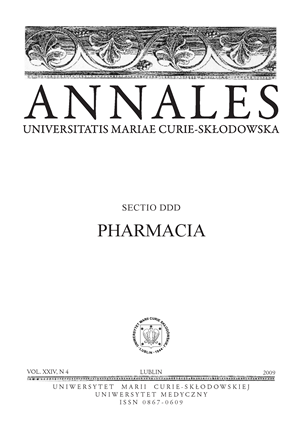Study of calcium and magnesium levels in dietary supplements containing antioxidants available in the Polish market
Abstract
Dietary supplements enjoy great popularity among consumers as their application is a comfortable way of supplementing an everyday diet in deficit substances indispensable for proper functioning of the human organism. An important group of dietary supplements is constituted by the preparations containing antioxidants protecting the organism from free radicals. The market is abundant with many preparations containing antioxidants, as those applied in the prophylaxis and as supplements in the therapy of eye problems and those containing garlic which present multi-aspect action. Dietary supplements are often plant components which are rich in compounds of antioxidative action such as plant polyphenols (phenolic acids, flavonoids), carotenoids and mineral substances (as parsley or garlic). Continuing the research aimed at the determination of the chosen mineral components in dietary supplements, the levels of calcium and magnesium (the macroelemts indispensable for man) in the preparations containing the antioxidants were determined. The chosen dietary supplements applied in the prophylaxis and therapy of the organs of sight (Aronia z luteiną, Bilberin, Maxi Vision, Naturapia wzrok, Oculobon, Pro-wzrok, Vitalux) and the preparations containing garlic in their composition (Aktiv Kapseln, Aliovital, Alitol, Bio-czosnek, Czosnek forte, Czosnek z pietruszką, Garlicin, Tabletki z czosnkiem) were analysed. The levels of calcium and magnesium were determined by the application of the flame absorption method (FAAS) using SOLAAR M5 spectrometer of Thermo Elemental. The levels of calcium in the studied dietary supplements ranged in a broad spectrum, on average from 6.98 ± 1.25 μg/g (Aronia z luteiną) to 2137 ± 166 μg/g (Maxi Vision) and up to 5299 ± 951 μg/g in Czosnek z pietruszką preparation. The smallest amounts of magnesium were contained in Aronia z luteiną preparation, on average – 3.34 ± 0.50 μg/g while the highest levels of this element were determined in Czosnek z pietruszką supplement, on average – 2997.8 ± 439 μg/g. The levels of calcium and magnesium in the studied dietary elements were diversified and they depended on their composition. Determination of these elements may constitute a supplementation of the daily need of the human organism for these macroelements.
References
1. Błoniarz J., Zaręba S., Rahnama M.: The levels of calcium and magnesium in dietary supplements. Monografia pod red. K. Pasternaka „Pierwiastki, środowisko i życie człowieka”, Wydawnictwo „System-Graf”, Lublin 2009.
2. Hankin J.: Keeping up with increasing popularity of nonvitamin, nonmineral supplements, J. Am. Diet. Assoc., 100, 419, 2000.
3. Kessenich C. R.: Calcium and Vitamin D Suupplementation for Postmenopausal Bone Health JNP, (3), 155, 2007.
4. Kim S.H., Han J. H., Keen C.L.: Vitamin and Mineral Supplement Use by Healthy Teenagers In Korea: Motivating Factors and Dietary Consequences. Nutrition, 17, 373, 2001.
5. Krejčová A. et al.: Determination of macro and trace element in multivitamins preparations by inductively coupled plasma optical emission spectrometry with slurry sample introduction. Food Chem., 98,171, 2006.
6. Leśniewicz A., Jaworska K., Żyrnicki W.: Macro- and micro-nutrients and their bioavailability in polish herbal medicaments. Food Chem., 99, 670, 2006.
7. Moyad M. A.: The potential benefits of dietary and/or supplemental calcium and vitamin D. Urologic Oncology, 21, 384, 2003.
8. Opara E., Rockway S. W.: Antioxidants and Micronutrients. Dis. Mon., 52, 151, 2006.
9. Piet ruszka B., Brzozowska A.: Witamin and mineral supplement use among adults in central and eastern Poland. Nutr. Res., 19, 817, 1999.
10. Pinta M.: Absorpcyjna spektrometria atomowa. Zastosowanie w analizie chemicznej. PWN, Warszawa 1977.
11. Power M. L. et al.: The role of calcium in health and disease. Am. J. Obstet. Gynecol., 181, 1560, 1999.
12. Sebast ian R. S. et al.: Older Adults Who Use Vitamin/Mineral Supplements Differ from Nonusers in Nutrient Intake Adequacy and Dietary Attitudes. J. Am. Diet. Assoc., 107, 1322, 2007.
13. Stoś K. et al.: Suplementy diety jako źródło składników o działaniu odżywczym i innym fizjologicznym. Żyw. Człow. Metabol., 34, 1036, 2007.
14. Swaminathan R.: Magnesium Metabolizm and its Disorders. Clin. Biochem. Rev., 24, 47, 2003.
15. Sygnowska E., Waś k iewicz A.: Rola suplementacji w uzupełnianiu niedoborów witamin i składników mineralnych w diecie Polaków objętych badaniem WOBASZ. Bromat. Chem. Toksykol., 41, 389, 2008.
16. Ziemlański Ś.: Normy żywienia człowieka. Fizjologiczne podstawy. PZWL, Warszawa 2001.
17. Źródło: Raport „Rynek suplementów diety w Polsce 2009”. PMR Publications, dział PMR, 2009.
Downloads
Published
Issue
Section
License
Copyright (c) 2009 Authors

This work is licensed under a Creative Commons Attribution-NonCommercial-NoDerivatives 3.0 Unported License.


